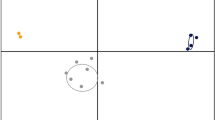Abstract.
Paspalum notatum is a subtropical grass widely distributed in the temperate areas of America. Diploids are sexual while polyploids give rise to clonal seeds through aposporous apomixis. RAPD markers were used to analyze the genetic structure of three natural populations: i) diploids reproducing sexually (R2X); ii) sympatric apomictic tetraploids collected in the vicinity of the diploids (R4X); iii) allopatric apomictic tetraploids growing in isolation (C4X). The apomictic reproduction rate was evaluated by the use of molecular markers in progeny tests, while chromosome-counting allowed the verification of ploidy levels. Data revealed that the R4X group presented a variation considerably higher than that observed for C4X. Jaccard’s coefficients were used to produce a cluster diagram using the UPGMA method. All but one tetraploid genotypes grouped together and were associated to diploid genotype A21. The possibility of occasional generation of novel tetraploid clones from the interaction between tetraploid and diploid individuals is discussed.
Similar content being viewed by others
Author information
Authors and Affiliations
Rights and permissions
About this article
Cite this article
Daurelio, L., Espinoza, F., Quarin, C. et al. Genetic diversity in sexual diploid and apomictic tetraploid populations of Paspalum notatum situated in sympatry or allopatry. Plant Syst. Evol. 244, 189–199 (2004). https://doi.org/10.1007/s00606-003-0070-6
Received:
Published:
Issue Date:
DOI: https://doi.org/10.1007/s00606-003-0070-6




